Introducing the latest myCWT product and service enhancements
Building on our digital, omnichannel myCWT platform, our new products and services will simplify travel management for you and your employees – anytime, anywhere, anyhow.
Note: Featured services may not be available in your country at this time. Please reach out to your CWT representative for more details.
Hear from Chief Product Officer, Erica Antony as she shares the key product highlights of 2024, along with the key areas driving innovation.
-

2040: Baseline, Boom or Bust
As we enter an era of rapid transformation and unprecedented challenges, it is essential for travel managers, meeting & event planners, and corporate decision-makers to look ahead and frame our current strategic thinking with a clear vision of the future. Business travel and meetings and events (M&E) are poised for significant change over the next decade and a half, driven by a complex interplay of sustainability goals, technological advancements, evolving work models, and geopolitical dynamics.
In this paper to mark the 10th anniversary of our Global Business Travel Forecast, we explore, for the first time, a long-term vision of the future and potential trajectories through three distinct scenarios, each offering insights into how these forces should affect policy-making, budgeting and priorities. By examining these scenarios, we can better understand the diverse possibilities that lie ahead and the strategic imperatives required to thrive in each potential future.
Based on trajectory data analysis and interviews with industry leaders, behaviorists and climate tech founders, this forward-looking approach enables us to anticipate changes, strengthen our strategies, and make informed decisions that align long-term objectives. It is through this lens of foresight and adaptability that we can build resilience, seize opportunities, and navigate the complexities of the future.
We invite you to reflect on the insights presented, and consider how your organization can prepare for the opportunities and challenges that lie ahead. Together we can ensure that travel and meetings remain catalysts for growth, scalability and sustainable practices.
- Scenario development is both an art and a science
- Megatrends Shaping the Future of Business Travel, Meetings and Events
- Sustainability goals the new crux of corporate policy
- Technology Revolutionizes Travel Management
- Modern work models spark new travel patterns
- Changing demographics open doors to new opportunities
- Three Scenarios: Base case, boom and bust
- Future-proofing strategies

-

CWT GBTA Global business travel forecast 2025
When it comes to pricing, global business travel has finally reached an enduring, higher baseline. Prices will continue to rise in 2025, but only moderately, so expect a period of normalized growth.
However, this pricing environment, one of marginal gains and price regularity, is fragile. Global leisure travel has now realized a lot of its pent-up demand, while corporate travel has been resurgent, with 2024 edging at preCovid levels.
There are many factors at play, whether its volatile oil prices, labor costs and constraints, inflationary pressures, and geopolitical factors. As this elevated baseline edges upwards, albeit marginally, travel budgets will come under increased scrutiny, especially as travel patterns and attitudes change.
It’s why business travel can’t be viewed in a silo, and the true value to an organization must be fully realized. This forecast can help with those calculations.

-

Capitalize on emerging technologies in corporate travel
Technological advancements are accelerating at an unprecedented pace. How will emerging innovations like Generative AI, blockchain, and self-sovereign identity (SSI) transform corporate travel?
BTN and CWT probed global CEOs, travel managers, industry consultants and tech experts on the promises, questions, and expectations these innovations raise and how they are set to reshape traveler experience, cost control and service delivery in corporate travel and events.
Download and discover
- The technologies that will have the greatest impact on corporate travel in the next 2-5 years
- How these emerging technologies are poised to control costs, enhance service and security, and boost efficiency
- The critical challenges, opportunities, risks and roadblocks each innovation raises
- What travel managers, buyers and experts anticipate from these innovations

-

Together we stand – Joint efforts against human trafficking
Human-trafficking is a hideous practice that we, at CWT, battle every day by organizing different actions throughout the year to embed it firmly in our Responsible Business strategy.
As covered in a previous blog post, there are different ways companies and organizations can fight it, two of them are helping those already in the battlefield and increasing employees’ awareness.
This is why, on the occasion of the 12th EU Anti-trafficking day that took place on the 18th of October, CWT’s Legal and Responsible Business teams partnered with the Association of Corporate Counsel Europe to organize a forum in CWT’s Paris office to talk about what CWT and other organizations are doing in this field:
- ECPAT, a network of local civil society organizations and coalitions fighting to end the sexual exploitation of children around the world, was represented by Ludivine Pivon, Project Manager at ECPAT France: “We conduct awareness-raising actions aimed at the general public, training activities for key stakeholders fighting against child sexual abuse, and advocacy initiatives among national, European and international authorities. Recently, we launched the ECPAT France app (in French) specifically dedicated to informing a wide range of professionals about the sexual exploitation of children.”
- White & Case, a global international law firm that has been doing important pro bono work on subjects such as human trafficking, domestic violence and torture, was represented by Anne Sophie Oberreiner, Staff Attorney, who spoke about the firm’s recent actions: “White & Case team researched, drafted and delivered a Global Study of Laws Relating to Sexual Exploitation of Children Online. We created a global database on the online sexual exploitation of children in more than 90 countries for our pro bono client ECPAT.”
- From CWT, Françoise Grumberg, Vice President Global Responsible Business, presented the recently created Anti-human trafficking task force, and the work which has been done to fight against human trafficking through reinforced policies, more awareness, and education and closer collaboration with stakeholders:“CWT is in a unique position to make a difference by raising awareness among our sphere of influence, such as employees, travelers, suppliers and clients.”
I shared with the audience the call for action presented at the International Summit on Child Protection in Travel and Tourism, in Bogota, Colombia in June 2018, and invited the audience to build upon it to ensure the protection of children in the travel and tourism industry and end impunity. The participants shared their ideas on how to engage in the fight through employee and traveler training, education for children in schools, awareness-raising through social media, and the creation of an international repository for data on this topic.
-
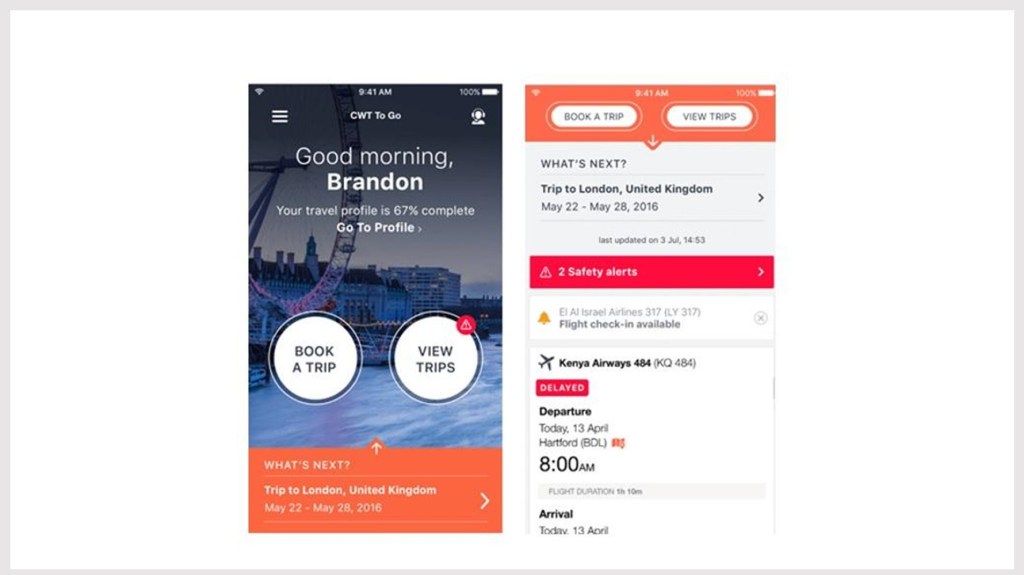
Always alert –The importance of having the right information at your fingertips
If you are a certain age you might find the sight of commuters with their noses glued to their phones on the metro every morning, of people walking in the street like pinballs or your kids treating their smartphones like a precious limb, annoying.
Like it or not, mobile technology has changed our lives immensely but when it comes to travel, I believe it’s for the best.
If you are a Millennial, you might not know what I am talking about but not so long ago we used to travel with a set of printed documents like air tickets and hotel reservations. We needed to ask for directions and couldn’t use Google Translate to read signs and menus.
Nowadays, we can download our itinerary to our phone, check-in, book flights and hotels, and so much more.
The advantages of mobile technology are clear. As a frequent traveler I rely on our app, myCWT mobile, formerly known as CWT To Go.
As well as getting updates and alerts on travel itineraries or changing plans, the improved tool has just introduced a key feature: safety, security and medical advice based on booked itineraries.
According to research that we published last year, 46% of travelers were concerned about their safety and security while traveling. So this new improvement answers our clients’ needs and allows them to have the same experience no matter the way they use to interact with us, and something that is far more important: they can have this vital information at their fingertips without needing to fire up their laptops. They are covered every step of the journey.
We live in uncertain times and, in the past few years, we have witnessed some horrible attacks in places we thought were safe. Now, our phone can be our guardian angel and make us aware of key events that might affect our trip, pose health threats, or increase our safety and security risks.
It can also help us to monitor relevant situations, such as severe weather, transportation strikes and epidemics. All this information will help us to be better prepared to manage or avoid potential trip disruptions.
With all of this, you might be converted and even fall in love with your phone like Joaquin Phoenix with Samantha in Her.
-

Rising power – Women in the energy, resources and marine sectors
According to the World Economic Forum the participation of women in the oil and gas industry remains below 20% and between 10% and 15% at senior level.
Being able to integrate different worldviews is a tremendous advantage that companies should not neglect. At the end of the day, organizations are a reflection of society.
That’s why we strive to create an environment that promotes diversity, inclusion and equal opportunities for all, regardless of our ethnic and cultural backgrounds, age, sexual orientation, disability or gender.
To celebrate National Business Women’s Week® we had a chat with some of the top executives at CWT Energy, Resources & Marine, Carlson Wagonlit Travel’s specialized division, to gather their views on industries still very much dominated by men.
Danièle Gadbois, Vice President, Global Business Development, leads the global ERM business development efforts after holding different executive roles within CWT’s Customers organization. She was awarded the GBTA Business Travel Professional Service Award.
Lucy Gibson, Global Travel Experience Director, oversees the counselor teams servicing ERM business globally. Once her two daughters were in school, she embarked on her management career, with one of the highlights being her involvement in Operational Excellence, earning her LSS Greenbelt certification. She will celebrate her 30th anniversary with CWT next year.
Lynn Galovich,Senior Director, Global Client Management Americas, leads a team of client managers that are dedicated to ensure that CWT delivers on its promise to meet or exceed at every turn. Lynn has over 27 years of travel and meetings management experience and is certified as a Green Belt in Six Sigma.

In a previous blog post, we already covered the importance of diversity for organizations. Are you seeing a positive evolution in the ERM industry with regards to women?
Danièle: Yes! We are seeing more and more women taking positions of leadership within the ERM client base. Diversity and inclusion are top of mind for many of our clients. Despite the strides that have been made, there are still many areas where women are under-represented in the industry.
Why do you believe it is important to have women in decision-making roles in this traditionally male-dominated industry?
Lucy: I believe that the right person for the job should be based on the ability to get the job done effectively and efficiently. Bypassing a woman just because of her gender puts companies at a great disadvantage as they could be passing up the best ‘man’ for the role.
Have you had any experiences that have shocked you or reminded you that while there’s been a lot of progress, there’s still a long way to go?
Danièle: I have often had personal experiences of being the only woman in the room in a prospective business meeting or, depending on the culture, have been dismissed or undervalued in discussions. I believe it is important, regardless of industry, to do your homework. Understand who you will be meeting with, what cultural practices they may observe, and be sensitive to those needs.
Any that have really encouraged you?
Lucy: Many of our top ERM clients have women heading up their global travel programs. This is very encouraging to me as it illustrates that, more and more, companies are choosing the people to lead their companies based on credentials, not gender.
How important is it for women to mentor other women, especially those on a leadership track? Have you been mentored? Are you a mentor?
Lynn: Mentoring is a great opportunity for both the person aspiring to be a leader as well as for the mentor. For example, I, as a mentor, can learn from young professionals. They can teach me the newest technology and philosophies of millennials, and I, in turn, can help them understand the responsibilities specific to a job role, the industry ins and outs, business acumen as it relates to policies, procedures, business relationships, and career pathing – both stay ahead of the curve.
A leader that promoted mentoring and networking among women in our industry was Karyl McCurdy Lawson. In 1994, she founded the Women’s Energy Network (WEN) to connect professional women across the entire energy industry and to address their need for leadership, development, education, mentoring and a network.
In the male-dominated energy industry, women lacked access to a forum where they could be exposed to successful female leaders and colleagues who could share their life and career issues. In addition to empowering women energy professionals, Karyl also included a charitable mission of giving back to underserved women and children as a key part of WEN’s core values.

In our 2019 Energy, Resources & Marine Travel Forecast we state that renewables are the fastest-growing energy market and many industry sources affirm this is a field where women are gaining momentum. Do you agree?
Danièle: Yes, definitely! We are seeing more women in all sectors, from management to engineering to grassroots development be included as employees in the renewable space. Renewables are the future. Potentially because they are focused on tomorrow and are new and up and coming companies, their leaders have taken gender equity more seriously. There is still a way to go, but we are seeing progress quicker in this sector.
What’s the business case for gender diversity within certain areas of ERM?
Lucy: I feel that renewables represent a new era of ERM, one that is more open to equality and modernism. This sector is all about innovation and looking to the future where our daughters will not know the boundaries that our mothers did. In order for there to be true equality, women need to enter fields currently dominated by men. Even though more women are entering the ERM industry, they are traditionally doing it in HR, administration, accounting, or counselor roles. By encouraging non-traditional paths we will, in turn, see the equality scales even out.
Are there any roles within ERM that are particularly male-dominated? Why is that? How can that be changed?
Lynn: Yes, it could most definitely change, but the reality is, most of the facilities and expectations of the job disproportionately favor men, i.e. demands of the job (more strength-related in some cases), camp/room accommodations, rotational schedules, social situations, etc. This is definitely changing as it relates to some of the more technical supported areas, such as engineering, R&D and corporate, but the rigs have a definite lean towards a masculine environment.
Are there new roles that will be created or changes that will level the playing field?
Danièle: The diversity and gender gap is being addressed by the industry as a whole. For example, SPE, the Society of Petroleum Engineers, has created a “Women in Energy” (WIN) committee to promote gender diversity in the E&P sector. In the UK, the Energy Leaders’ Coalition has pledged to improve gender diversity within its member companies. It is my belief that increasing the number of women in leadership and middle management positions will have a trickledown effect in bringing more women into the industry.

What are, in your opinion, the main challenges women face nowadays to enter the industry?
Lucy: Credibility. Even though you do not see many women at senior levels within the industry, you see even fewer as roughnecks on an oil rig or as merchant seamen. This represents a challenge in articulating that you know their business without having walked a day in their shoes. Knowledge is key in these situations, proving that you have invested the time to understand their concerns, and providing effective solutions to their issues.
What can the industry do to accelerate the inclusion of women?
Lynn: Continue to raise the awareness of this topic, promote an energy career path on college campuses, and have women representing this workforce speak to others as members of the committee, on a board, or for recruitment blitzes. O&G corporations are doing a good job of changing the perception of this as a male-dominated world by promoting the human side of energy, working towards more work-life balance for both male and female. This has increased the younger professionals’ interest in this field with a focus on the environment and a vital career path in this industry. All this will result in a more diverse and deep employee base, drive employee satisfaction and retention.
What can companies do to attract and retain women throughout their career?
Danièle: Some of the areas where companies could work to attract or retain women would be to offer policies to help support children and families. In order to advance in leadership in the ERM field, many companies require international experience. Companies who can make those international opportunities easier for women and families to achieve will ensure women can gain the experience they need to move forward within an organization.
What would be your advice for women seeking careers in ERM?
Lucy: If this is a space you are interested in, hard work, networking, and knowledge are key. Learn about the roles that interest you, obtain the credentials you need to be taken seriously, and request to be taken on as an intern to gain experience.
What specific changes would you like to see for women in ERM in the next five, 10, 20 years?
Lynn: As of 2018, women make up only 20% of the global oil & gas workforce, according to a study by Boston Consulting Group. We all know as we move forward the amount of employable workers is decreasing, so in order to attract and retain the business, companies need to think of how best to secure a more diverse workforce overall. An increase in training to help both women and men feel inclusive together in these tough work environments is critical.
Safety and security is always a concern in ERM travel, especially as many key markets or exploration hubs are located in volatile areas. What can companies do to address specific concerns for female travelers?
Danièle: Companies need to work with their risk management departments to ensure travel policies have sections built in specific to women’s safety. They can work with organizations such as GBTA to gain case studies and references from other companies who have done this. Also, many companies in the ERM space will work with third party safety and security companies who can help make recommendations to policy. The most important aspect is to think of women as a subsection of the traveling population and ensure the current travel policy addresses the security needs for all travelers – women included.
Are there countries where local business culture makes it very hard for female ERM professionals?
Lucy: I feel it is our responsibility as women to be respectful of all global cultures. When traveling or interacting virtually with international clients or teams, I read up on the local culture to ensure I am presenting myself in a respectful and engaging manner. Many countries have hierarchical societies, so knowing your audience is key.
Can you share with us some good practices?
Lynn: Safety and security are paramount for all travelers, specifically for women. Safety around ground transfers, secure accommodations, security in camps and rigs are all best practices and policies that can be adopted to help the confidence levels rise for women wanting to enter specifically in the rig, drilling and oilfield services arena.
Find out more about diversity and inclusion in CWT’s Annual Responsible Business Report.
-

Then we take Berlin – Top tips from our local expert for unforgettable meetings and events in Europe
According to a CWT Meetings & Events’ trends report, the top destinations for 2019 in Europe, Middle East and Africa (EMEA) will be London, Moscow, Barcelona, Berlin, Hamburg, Vienna, Stockholm, Cologne, Paris, and Frankfurt.
With Europe dominating the panel, and Germany ranking first in terms of representation with four cities making it to the top ten, we interviewed Ian Cummings, EMEA Vice President at CWT Meetings & Events, to find out which is his favorite destination in the region and why.
CWT Meetings and Event delivers 38,500 innovative, high-quality projects for customers every year – across all industry sectors, globally – he certainly has a lot to say about the top destinations in his region to host awe-inspiring events and meetings that maximize the return on investment.
London was voted number one for 2019. Why do you think that is?
London is always a favored destination for private, luxury, and business travel. It’s serviced by four major airports and, therefore, in terms of accessibility, it is one of the best locations in the world. As people value their meeting time so much, minimizing travel time is a key driver. There are also so many great new hotel openings happening… These, coupled with the devaluation of the £GBP, make London very attractive.
From the list, which city is your personal favorite? Why
Personally, I love Berlin as a city, especially its vibrant and exciting development as a tech/investment/startup hub. But all the cities on the list hold exciting opportunities. Stockholm is a great city, particularly in the summer, and everyone loves Barcelona and Paris!
Where would you recommend to stay in Berlin?
For Berlin, two cool hotels are the nhow Berlin, which is actually four stars but a very exciting property, as well as the five stars Hotel de Rome by Rocco Forte. I am also a fan of the Soho House properties and restaurants such as Cecconi’s that is obviously opened to the public in the same building.
Best place to eat in Berlin?
Head to the super cool and local Pauly Saal where you have a lounge bar, private dining up to 30 and contemporary art on the walls, but be sure to book well in advance of arriving in Berlin! Tausend is also a cool restaurant and bar/club for a full evening.
Favorite local specialty?
Go for some Schnitzel, you can find some of the best in the world.
Best shop or market?
My favorite store in Berlin is hands down “The Store.” It’s part store, cafe, market, and music hall and it’s uber cool.
If they only have 24 hours in Berlin, what must visitors do?
Take a Segway around the city, do a hot rod tour and hit the Berghain nightclub early to avoid the crazy queues – that is if the doorman lets you in.
What about just an evening?
Drinks at The Monkey Bar on the 10th Floor of the 25hrs Bikini Hotel – do sundowners, love the view and enjoy the DJ.
And a few days?
All of the above plus a cycle tour, visit the Berlin wall museum, Checkpoint Charlie and take a lazy afternoon boat trip and visit some stunning art galleries.
Top three coolest venues in Berlin?
Venues as in event spaces – Cafe Moskau, Soho House, and artloft.berlin.
Best personality or person from Berlin?
Peggy Gou – Producer/DJ.
Why is Berlin great for meetings and events?
It has great venues, plenty of hotel availability, a fantastic range of activities, great art and culture… It certainly has a cool factor and its nightlife is some of the best in Europe. It’s well served with two international airports, national as well as plenty of low cost carriers to keep the prices down.
Any safety and security tips to that city?
Like any other major European city, be proactive, be vigilant, avoid large gatherings if possible and do your research.
Favorite EMEA destination not on the list? And why?
Madrid – beautiful city, amazing food, good direct access, and good weather for much of the year.
What are your top cities for the other regions?
For Asia Pacific, I recently spoke at TIME 2018 in Bangkok – it’s an amazing city and has come a long way for meetings and events, and Miami is always a great location for pleasing your delegates – such a great fun city!
-

Is there a business case for creating a better traveler experience?
Leading organizations know there’s a strong business case for putting traveler experience at the center of their strategy. Data shows it improves retention, boosts performance, and even lifts the bottom line. These lessons now need to be applied to travel, says CWT’s new Senior EVP Chief Travel Experience Officer. Here, he tells us why.
I had a great time participating in an interview to conclude ACTE Paris. It was my first CWT corporate travel event and a really exciting way to celebrate seven weeks in my role as Senior EVP Chief Travel Experience Officer.
I have spent my entire career in travel in different dimensions but I felt that I was missing that direct connection with the traveler. I could see technology reaching a point where it will for the first time allow companies to simultaneously achieve the goals of their travel programs and improve traveler experience. Also, I wanted to see how a travel policy can become part of a company’s wider culture, and I wanted to be part of that transformation.
It has been great to see how CWT have combined the skills of our travel counselors with the capabilities created by our Product and Technology teams as well as the digital assets we roll out.
The Golden Triangle of business travel – Cost, performance and traveler experience
Part of our strategy with Traveler Experience is joining the dots between many masters. I think of it as a holy trinity: the cost of travel that needs to be managed, performance – what you expect to achieve by sending someone on a business trip, and the experience your people have when they are traveling. We used to think about these things in a silo and also quite often see them as mutually exclusive but it’s essential that we transform our thinking. It’s “both, and”. It’s not “either, or”.
My focus is making sure we can define the optimal solution between the three for our clients. We know from research that successful companies are using employee engagement to drive other areas of the business: namely recruitment, retention, performance, and savings. It’s the same in the business travel sector. There’s no longer a binary effect between cost and service. It no longer has to be the case that effectively managing your program needs to result in a worse service for your travelers.
With data science and tools like personalization, we have the opportunity to play around with the three points in the triangle to find the ideal mix for each and every company.
Here’s an example: In a past role I had to fly out to Chicago for a training week. Now, the old rule was that any flight over six hours was bumped up to business class. But I had no real need to fly business. On the other hand, if someone is flying for two hours to make the biggest pitch of their life and has a two-hour flight, you want that person to step off the plane fresh, prepared and gunning for that deal. You probably don’t want them stuck in row 52G, with a kid drooling on their shoulder.
Of course, the challenge is we all have data coming out of our ears. It’s not always easy to know what to do with it. But companies that are able to truly understand what their data is telling them about the traveler experience they are generating, will have the power to develop systems that allow you to run a very cost-efficient program, as well as build a brand that resonates with your travelers.
Getting the green light from the C-Suite
During my interview, we looked onscreen at an ACTE “instant issue” poll taken over the course of the event.
It asked, “which of the following strategies do travel managers need more training on?” The results were cost savings (19%), traveler engagement (36%), and making a business case to senior leadership (45%).
I was not surprised by these results.
Yes, we’ve been talking about the traveler experience for a long time. But we haven’t truly been able to measure it using data. Now, technology is at a point where data can be used to make a well-rounded business case: To show how the travel program can drive the culture of who we want to be as a business, drive savings, and achieve return on investment (ROI).
The challenge now is how organizations change the conversation internally.
How do I engage with my travelers? How do I make a business case to start talking internally about this shift from just talking about cost – the binary – to defining what a holistic approach looks like?
Successful companies who are pivoting the conversation to a strategic and holistic view of travel aren’t trying to boil the world’s ocean.
They aren’t looking to technology to solve a problem within three years. This is because by the time you get to the three-year mark and you have solved the problem, there will be new ones.
Successful companies know where they want to head, understand the importance of the travel program in their company culture, and have figured out how to move the needle step-by-step while also taking their travelers along for the journey
What’s exciting is that more and more organizations are saying, “We can accomplish both.”
We are now all asking: What’s the actionable insight? What can we start to change today? and How can I make sure I service and engage travelers better across all the channels we use to interact with them?
Once travelers have the right tools, they change their behavior naturally. You will have fewer discussions around compliance. Instead, the discussion will be around how you help travelers get the most out of the tools you provide.
-

Staying power – How your hotel policy can help win the battle for top recruits
It’s a tough job market for employers. If you want to attract the top recruits, you’ll have to fight for them. When taking new roles, many employees want benefits that offer better work-life balance like more paid time off and flexible work arrangements.
For those who travel frequently, a good travel policy is essential to work-life balance and can be a key factor when determining whether to stay in a job or accept a new one. In fact, 59% of North American business travelers and 66% of Latin American travelers told GBTA that a company’s travel policy is an important factor when deciding to take a job with a new employer.
What can you do to make sure your hotel policy appeals to recruits?
- Offer convenient locations and properties
Time and time again, business travelers say convenience is their number one priority. It’s not an unreasonable request. Who doesn’t want an extra 30 minutes of prep time or sleep before heading out to a meeting?
Yet, if you only rely on GDS content, your hotel program may not offer properties at all of the locations your travelers visit. Offering properties from third-party hotel content sources like Booking.com and Expedia Partner Services can provide travelers with access to more locations and accommodation types (independent hotels, apartments, etc.) that are not available in the GDS. - Be realistic about rates
Beyond convenience, travelers want to stay somewhere clean, comfortable and safe. Quality matters. While price does not equate to quality, there are significant differences in average room night rates by location. When setting city caps, make sure you know average rates by city and how much rates are expected to grow. Carlson Wagonlit’s 2019 Global Travel Forecast can help you determine rate increases by region. Also, consider the type or class of property your travelers expect to stay at when setting rate caps. - Help travelers save time
Scrolling through pages of hotel property results trying to decide which hotel is the right fit – not so much fun. Neither is searching through several sites. Partner with a travel management company (TMC) that offers personalized search results. myCWT ranks properties by company’s travel policy, distance to destination (reference point one) and travelers’ and colleagues’ past stays, making it easy and quick to find the right room, right away. - Offer loyalty perks
Travelers care so much about loyalty points that they’ll risk their personal safety in order to earn them. Literally. 3 in 10 business travelers surveyed by CWT said they would sacrifice safety for loyalty points and incentives. The good news is that travelers can book rates with loyalty points through RoomIt. The even better news is that they can earn additional hotel loyalty points through Loyalty Booster, driving in-channel bookings to your preferred suppliers. - Make Bleisure easier
More companies are allowing travelers to add a holiday to the end of their work trips. However, most travelers book their trips through consumer sites. Make sure travelers are clear if they can take advantage of your preferred rates or TMC when booking personal extensions and how to pay for those accommodations so they can book their full trip all at once.
- Offer convenient locations and properties
-

On the ground – Assessing the impact of Brexit on business travel
This is the third in our series of blogs on the impact of Brexit on business travel and a timely day in which to delve into border concerns for corporate travelers.
As the European Council Summit is underway, a critical issue for both sides of the Brexit negotiation is the “Irish backstop,” an insurance policy to ensure the border remains open to trade, people and services in the event of a No Deal Brexit.
During this time of uncertainty, clear insight into life at the borders and ease of mobility is precisely what business travelers want. “Travelers want to know how their day-to-day lives will be effected,” says Johan Wilson, VP and Country Director UK & Ireland, “How long the queues will be at the airport and the paperwork they will need to hire a car. They want concrete facts amidst the speculation.”
For now anyway, concrete facts remain elusive. This is not a simple process. If the UK Government can negotiate a withdrawal agreement with the EU there will be a transition period after 29 March 2019 (Brexit day). During this time most aspects of UK membership of the EU will probably remain the same, including free movement across borders and membership of the customs union and single market.
If the impasse on the Irish border continues in October or the two sides require more time, there could be an Emergency EU Summit followed by a Council Meeting in mid-December, the current deadline for the negotiating teams to come to an agreement. If no deal is reached, there could be bilateral agreements based on World Trade Organisation (WTO) terms on areas including aviation.
“What we’re looking at is a ‘what if’ scenario,” says Wilson, “It’s always best to remain positive and focused, but prepare for any eventuality.”
In the UK there’s a growing movement for a final say on the deal, and a people’s vote. UK MP Rupa Huq from the People’s Vote campaign told The Independent in September, “No-one voted for a Brexit that results in flights being grounded or the Eurotunnel being closed down.”
Indeed it’s in nobody’s interest and remains an unlikely scenario. Our advice remains to keep an eye on unfolding negotiations and regulatory insight while looking at key areas for business travel. Based on governmental notices, we’ve prepared a checklist that outlines some potential changes that may occur in the event of a No Deal scenario. In our next post, we’ll look at the potential impact on Meetings and Events.
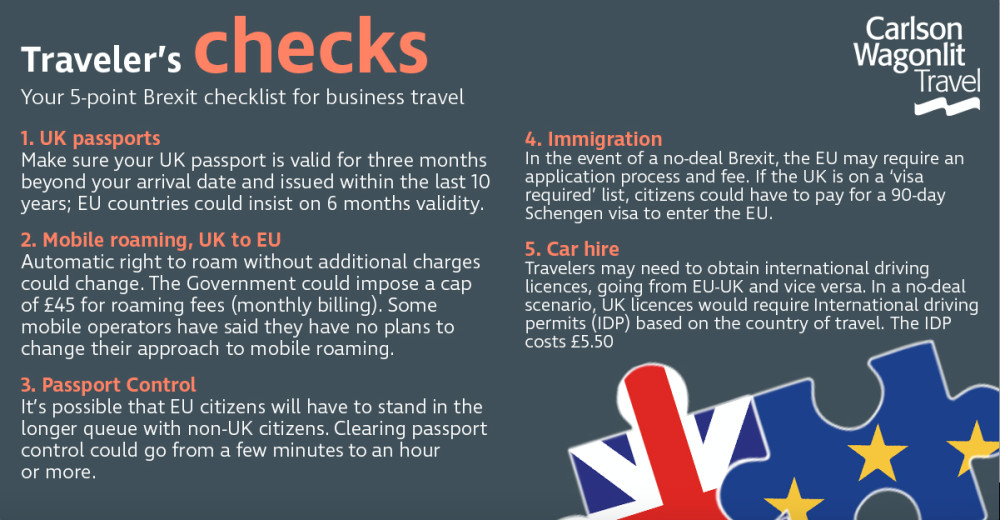
-

Perfect pairings – Industry collaboration meets travelers’ changing tastes
Tastes and trends change over the years. Just look at food. When you were a kid, “Eat your brussels sprouts” was something you had to do, not something you ever wanted to do. Then, chefs started roasting brussels sprouts topped with bacon and they became a food you actually craved.
Like food, travel is a very personal experience. With any personal experience, tastes change. For years, employees booked their corporate travel just as they would eat their childhood dinners. They did what they were told begrudgingly, without expecting a choice in the matter, because there were no other options available.
But, as we all know, when online travel sites became prevalent, business travelers realized they had choices – lots of them. They could research and book travel more easily – with access to photographs, traveler reviews, and discounted rates. As a result, their tastes, expectations and behaviors changed. Why do as they were told when they could get exactly what they wanted on their phone, laptop or tablet?
The downside of choice
While business travelers were happy to have more options, choice came with downsides for employees and travel buyers. Comparing hotels, reviews and rates takes quite a bit of time – time that could be spent working, rather than searching for travel.
Booking outside of corporate travel programs grew, causing travel buyers to lose insight into their spend and travel behavior and weakening their negotiation power with preferred suppliers. Of course, it also made it more difficult for travel buyers to fulfill their duty of care obligations.
Coming together to meet traveler and buyer needs
To meet travelers’ and travel buyers’ needs, travel management companies began partnering with a variety of industry providers to offer a greater breadth of content combined with a more sophisticated shopping experience.
Third-party hotel content integrations provide RoomIt’s clients (including CWT’s clients) access to more independent hotels, more locations and a larger variety of rates than previously available through global distribution systems. RoomIt then layers personalization efforts on top of this content to serve up accommodation choices that meet travelers’ needs within company policy, making it easy for travelers to make smart choices, quickly.
Additional tools and strategies have been implemented to tackle two other common causes of booking off-channel: low rates and loyalty. Some travelers still think they can find a better rate, not knowing that rate tracking services can shop and book lower rates with the same amenities at the same property for them. And, RoomIt partners with hotel suppliers to incentivize compliant bookings by offering bonus hotel loyalty points at company preferred hotels.
As James Filsinger, CEO of Yapta, puts it, “Attachment rates increase by providing the right content, at the right price, at the right time. When that fails, rate tracking can save your bacon.”
Looking to the future
Trends, tastes and technology will continue to evolve. Travel buyers will need to keep up with these changes in order to maximize traveler satisfaction and keep their costs in-line. Otherwise, travelers will continue to view their travel programs just as they did the overcooked, mushy brussels sprouts of their youth – something to avoid if at all possible, or at best, something to tolerate when the boss is looking.
-
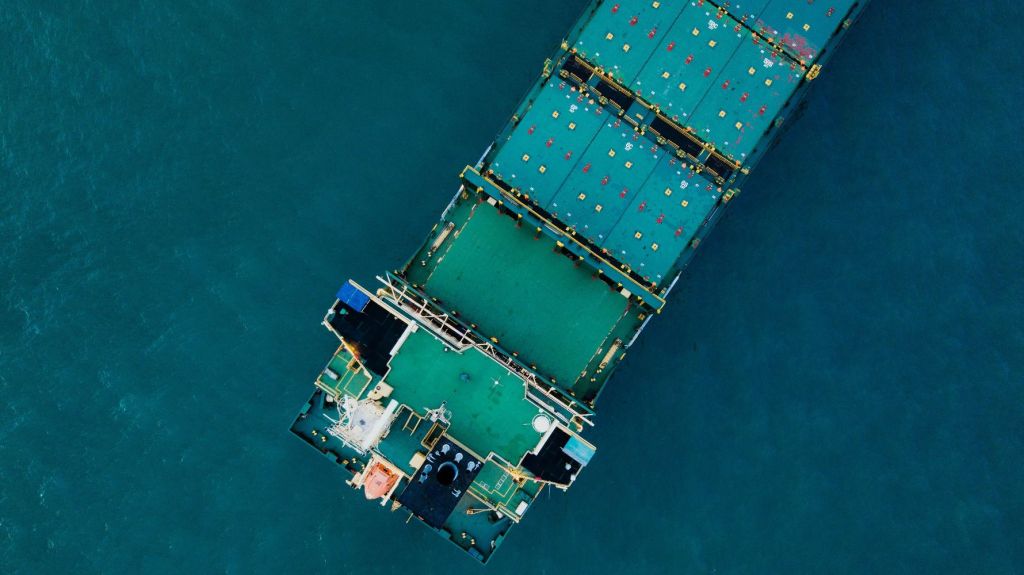
Energy, Resources and Marine Travel – Here’s how to manage it effectively in 2019
Managing a travel program can be complex even when the requirements are quite straightforward, so imagine what it’s like for travel managers in the energy, resources, and marine (ERM) sectors.
Getting people to remote and often dangerous places like the world’s deserts, Alaska and the open ocean is no mean feat.
Traveling from one financial center to another can be challenging enough. Traveling to the world’s most unusual locations like oil rigs and mines requires a whole different set of rules.
In a this blog post we shared the key things to bear in mind to negotiate travel successfully for 2019. However, if you work in the energy, resources and marine sectors you want to read these specific tips to help you keep the cost of travel down in a market on the rise.
- Know where (not) to save. Travel remains a significant cost for companies in the ERM industries and since air prices are projected to go up next year, companies might be tempted to go for the lowest available fares. However, in the long run this might not be a good strategy. Low fares are restricted, and often ancillary costs will drive up the price. Change fees are also to be considered so if your company has a fairly high change rate, a less restricted fare may be a better option on balance.
Tracking, data reporting, and regular analysis are your friends in this area: if you can put a number on your change rate, and either work to reduce it or use it to decide on the most appropriate fare, you will save money in the long run.
When it comes to booking hotels, it’s also worth looking at the cost efficiency of your strategy. Depending on the market, if your company is unlikely to book more than 150-300 room nights a year into a property, it’s probably not worth investing in negotiations. Instead, use an integrated service like RoomIt by CWT to get the best deals on properties with a lower travel volume. - Be prepared for emergencies. Always have a plan B and resources that can take care of the unexpected since a disruption in a flight can imply, for example, that a crew rotation can be missed on a rig. That can halt or delay work on the rig, something that can end up costing a company millions of dollars a day.
For instance, during Hurricane Harvey, 95% of CWT Energy, Resources and Marine’s agent workforce in Houston were up and running, working around the clock on more than 121,000 cancelled and delayed flights, and putting in an additional 4,000 hours across the network—before, during and after the storm to minimize impact on clients.
Safety and security are also key. You need to be able to look after everything: from large-scale rig evacuations to locating and assisting individual travelers around the globe. CWT Energy, Resources & Marine has in place crisis management processes that include emergency alerts, traveler tracking, evacuation, and repatriation, as well as other crisis and risk management assistance to help you out with this very important task. - Use technology (and people) to your advantage. Technology plays an increasingly large role in everything we do, and travel booking is no exception. Mobile booking is on the rise too. That said, consider all available booking channels in order to find the perfect blend of human and digital for your company.
Not all bookings can be made online: Online Booking Tools (OBTs) generally don’t include Offshore & Marine Fares and don’t allow for group bookings.
Define what you can easily do online and what is better left to travel consultants. This will save you money and leaves consultants free to deal more efficiently with complex requests. - Always consider the traveler. Ultimately, your people are what matter most in keeping your company running. While it is advisable to keep travel policies tight in times of economic prosperity, it is important never to lose sight of the traveler and their needs when establishing those policies.
Generally, travelers want to do the right thing and follow policy guidelines so we advise you to trust your travelers and let them inform your policy decisions. Handing them tools to encourage them and increase compliance, like customized mobile booking tools and interactive itineraries, can help with this. You will gain a happier, healthier travel population, and, ultimately a more robust policy.
- Know where (not) to save. Travel remains a significant cost for companies in the ERM industries and since air prices are projected to go up next year, companies might be tempted to go for the lowest available fares. However, in the long run this might not be a good strategy. Low fares are restricted, and often ancillary costs will drive up the price. Change fees are also to be considered so if your company has a fairly high change rate, a less restricted fare may be a better option on balance.
-
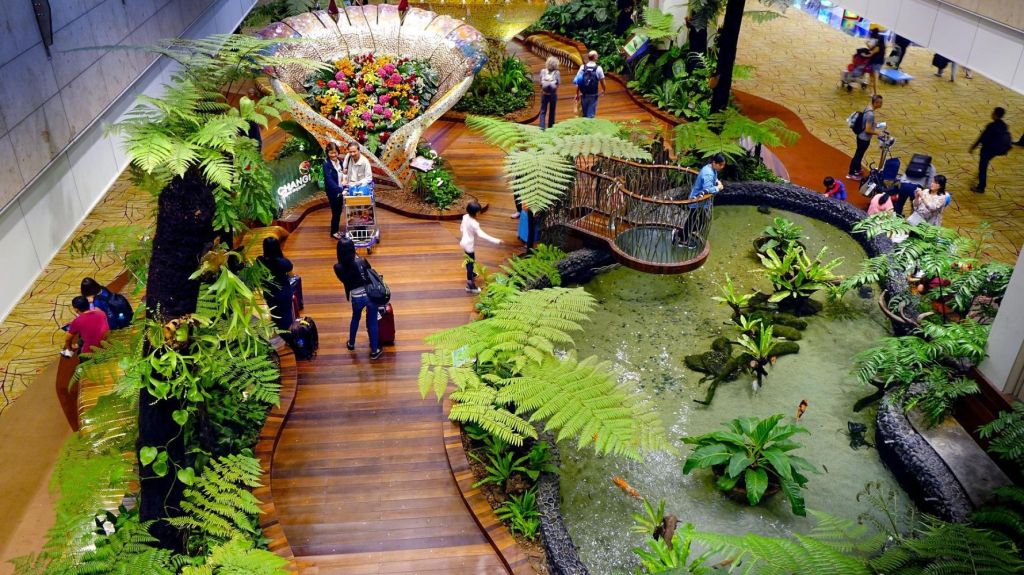
CWT’s Airport Index identifies Singapore’s Changi as the top airport for Australian business travelers
Carlson Wagonlit Travel (CWT), a leading global digital travel management company, has published its first ever CWT Airport Index for Australia. Singapore’s Changi Airport emerged as the best airport for business travel in the study of 15 airports around the globe frequently visited by Australian corporate travelers.
“Changi Airport is known for being a breeze to get through,” said Michael Ryan, Managing Director, Australia / New Zealand, Carlson Wagonlit Travel. “Lounges and lounge amenities were identified as priorities by our customers, which Changi offers in spades, including several pay-per-use lounges and free-to-use rest areas. Another major plus is that all X-ray checks are done at the gate, which saves travelers a lot of queuing time.”
Sydney Kingsford Smith Airport took the number four spot, making it the top-ranked Australian airport in the study, thanks to the many lounge options travelers can choose from at the airport, and the quick and easy access to the city center.
The index scores airports on seven criteria to gauge out how responsive they are to the needs of corporate travelers. These include: number of airport lounges; Wi-Fi availability; self-service check-in availability; time to the CBD by taxi; time to the CBD by train; percentage of on-time flights, and the number of airlines flying to the airport.
The five top-ranked airports are:
- Changi Airport (Singapore, Singapore)
- Suvarnabhumi Airport (Bangkok, Thailand)
- Heathrow Airport (London, United Kingdom)
- Sydney Kingsford Smith Airport (Sydney, Australia)
- Narita International Airport (Tokyo, Japan)
The top-ranked airports in Australia are Sydney Kingsford Smith (#4), Melbourne Tullamarine (#7) and Brisbane (#9).
London’s Heathrow Airport scored top marks for comfort with 44 lounges, including several pay-per-use lounges which can be used regardless of which airline a traveler is flying with or their class of travel. Heathrow also offers other options for corporate travelers to unwind between flights, including day beds, bedrooms and massage spots, across its four terminals
Other airports that score highly on comfort are Bangkok’s Suvarnabhumi Airport with 31 lounges, and Tokyo with 29 lounges. Sydney Kingsford Smith topped the domestic table with 22 lounges, followed by Melbourne Tullamarine with 20 lounges, and Brisbane with 13 lounges.
Looking at technology and connectivity, the majority of the airports identified as key hubs for
Australian business travelers have free, easily accessible Wi-Fi outside their lounges, alongside self-service check-in or bag drop options. Still, Changi Airport came in at the top for technology-enabled travel, with a host of other features such as a fully automated check-in system with electronic tagging and automated baggage drops, and a 3D CT scanner so that laptops don’t need to be removed from carry-on bags at security.
Hong Kong International and London Heathrow came in second and third respectively in the technology and connectivity category, with both airports making significant investments in upgrading their facilities.
Changi Airport ranked best for transport links, too. It takes approximately 30 minutes from the airport to the central business district (CBD) by taxi on a weekday morning, and costs around AU$20-30. Alternatively, travelers can take the Mass Rapid Transit (MRT) subway system, which takes around 53 minutes from the airport to the CBD, with trains running every two to three minutes at peak times, and every five to seven minutes in off peak times.
San Francisco International Airport and Sydney Kingsford Smith also shared the top spot with Changi for transport links. It takes just shy of half an hour by train from San Francisco International Airport to the CBD, while a train from Sydney Kingsford Smith will get you to the city center in around 20 minutes.
Examining on-time flights, Canberra, Perth and Brisbane airports flew the flag for Australian efficiency. Data compiled by FlightGlobal indicates that, on average, 87.3% of flights at Perth Airport were on schedule between April 2017 and April 2018 – higher than the average of around 80% for the 15 airports reviewed in the study. Canberra and Brisbane airports came in second and third, with 86.5% and 85.4% of on-time flights respectively. Melbourne Tullamarine ranked sixth with an on-time performance score of 81.8%, while Sydney Kingsford Smith ranked eighth with 80.6%.
“Staying productive is the top priority during a business trip,” added Ryan. “This means maximizing the time that you’re able to work during transit. It also means you need to arrive at your destination on time, refreshed and in the right frame of mind for your meetings.”
“Airports with facilities such as free Wi-Fi, automated or express check-in systems and a good number of lounge options can mitigate some of the stress experienced by business travelers. It’s great to see airports across the globe, including many here in Australia and the Asia Pacific region, using technology to make travel hassle-free.”
Research published by the CWT Solutions Group in 2013 identified flight delays, lack of internet access, and having to fly economy on medium- or long-haul flights as top stress triggers for business travelers. The study found that, on average, business travelers lost 6.9 hours per trip due to stress, costing their companies the equivalent of US$662.
Carlson Wagonlit Travel
Companies and governments rely on us to keep their people connected. We provide their travelers with a consumer-grade travel experience, combining innovative technology with our vast experience. Every day, we look after enough travelers to fill more than 260 Boeing 787s and 100,000 hotel rooms – and handle 105 events. We operate in around 150 countries, and in 2017 posted a total transaction volume of more than US$ 23 billion.
-

How tech will revolutionize meetings and events
Technology is altering the landscape of meetings and events, according to the 2019 Meetings and Events Future Trends report, and will continue to do so in the near future. Augmented reality, artificial intelligence and data analysis tools allow meeting planners to save time and expense and raise expectations by taking simple concepts to the next level.
Creative execution will be aided by augmented and virtual reality but technology will also assist with everyday tasks through meeting management tools and event apps. According to CWT Meetings & Events Commercial Director UK & Ireland, Chris Goundrill, 80 percent of requests have a technology requirement and this is likely to increase as planners understand the benefits of technology.
Virtual meeting technology will become more popular, although there is no real worry about it taking over face-to-face meetings. Most global offices have international clientele and offices all over the world. Communication between teams in different countries is not always feasible face-to-face, especially when travel costs and time are considered. However, with the support of software and advanced technology, there is a new vision known as “phygital” – a cross between physical and digital meetings.
Augmented and virtual reality (VR) will become more widespread too. Since more people within the meetings and events industry have begun to see a need for advanced VR, prices have reduced for the equipment. It will be used even more to represent spokespeople unable to attend by using a hologram. Not only is it practical and cost-effective, AR and VR helps to drive attendee engagement.
Artificial intelligence (AI) including bot technology and chat interfaces is also expected to boom in 2019. For meeting planners, AI provides a useful resource to direct information through messaging and chat. AI has already reached other areas of the hospitality industry and is showing great promise for meetings and events.
Time to ditch the PowerPoint and laser pen?
-
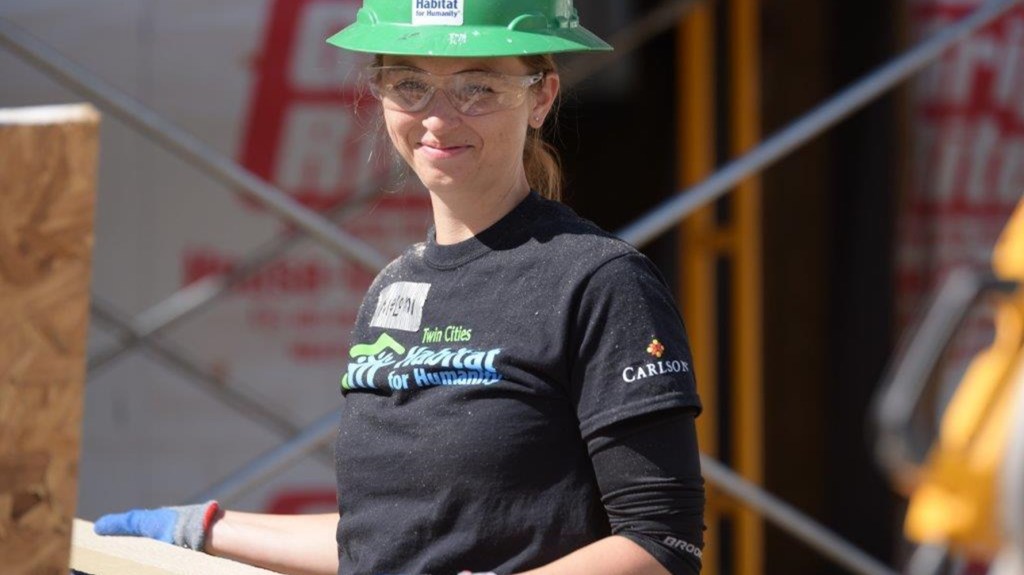
The Power of giving – Why companies should look after the communities in which they work and live
Eighty years ago, Curt Carlson launched a company with a product so small, you could hold it with the tip of your finger. It was a humble start for a company that today operates in more than 150 countries and territories around the globe. But something else, too, was born in the early days of a growing business. Carlson established a set of guiding principles. He believed successful corporations have the privilege and obligation of citizenship in the greater world, so he fostered the values of community engagement and philanthropy, integrity and leadership.
Much has changed in 80 years. But not, thankfully, our values. CWT colleagues in Minneapolis live them by hanging drywall for Habitat for Humanity homes and creating care kits for cancer patients. Our people in Manila champion them by coordinating projects to support schooling of underserved children across the region. Our teams in Washington D.C. stand for them while they donate their time and talents to help veterans.

“No man is an island, said poet John Donne. No company is an island either. We are an integral part of the communities in which we do business. We think that all of us are enriched by the relationship.”
– Curt Carlson
Giving is an exercise of the heart, and CWT colleagues in the United States set new records during a month-long sprint. Our 2018 Carlson Community Giving Campaign yielded a 25 percent increase in participation from 2017 and a 20 percent bump in fundraising. The robust support of volunteerism and employee donations fueled community partners and nonprofits across the country, organizations that are solving problems and confronting challenges in the areas of human rights and anti-trafficking, education and the environment, health and humanitarian crises, and more.
We are proud of our progress, and our people who are improving communities and changing lives. We know Curt Carlson would be proud too.
